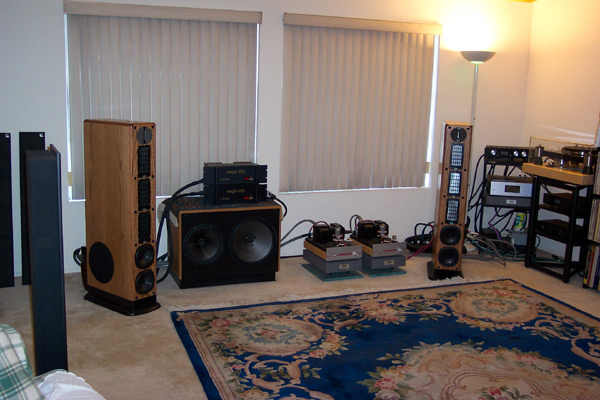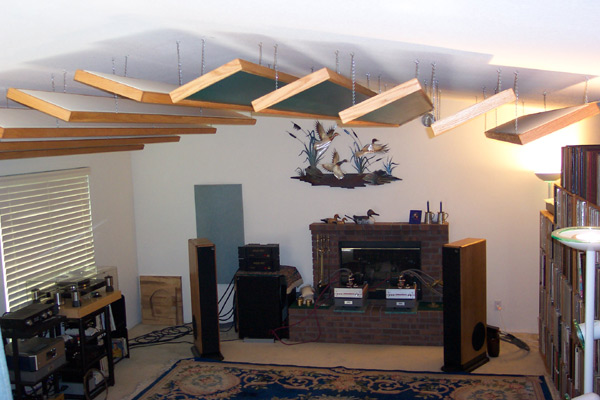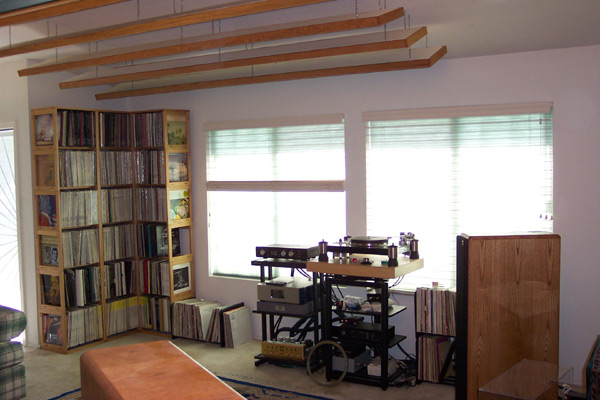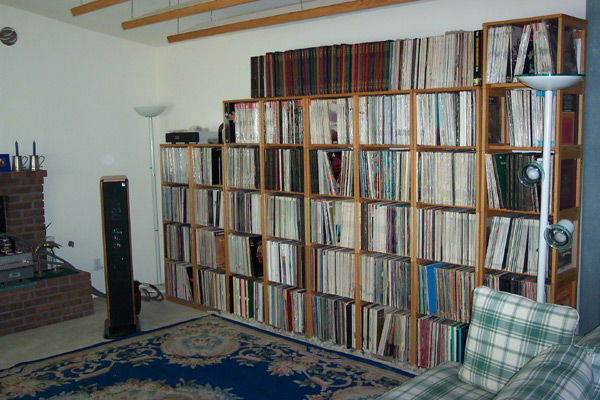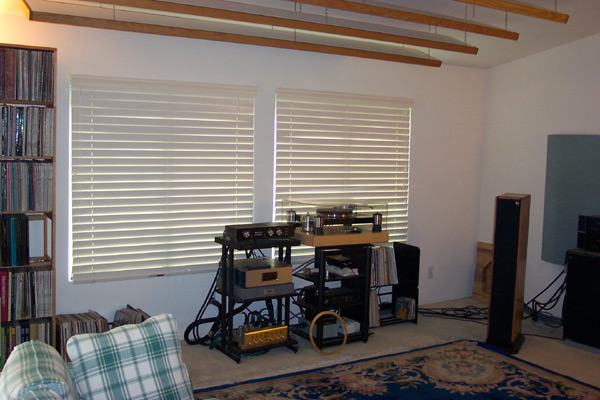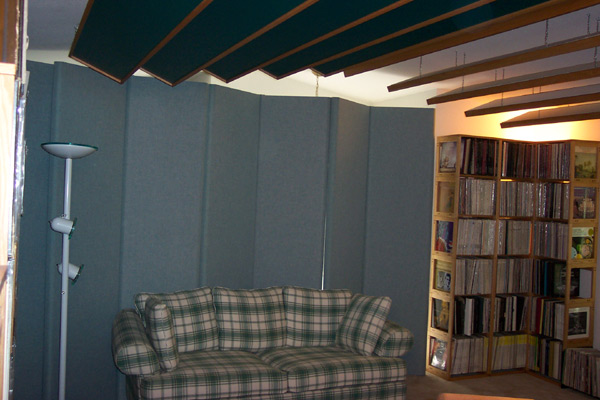|
You are reading the older HTML site
Positive Feedback
ISSUE
21
Room Acoustics - The Final Frontier To be an audiophile means your world is in a constant state of flux. Components go in and come out of the system on a regular basis. Power cords, interconnects, and speaker cables come and go almost weekly. Then there are the tweaks—the pucks, the brass cones, the wooden blocks, the carbon fiber platforms, the fifty-pound sacks of lead shot, the various unguents, creams, and potions. We try anything and everything to make our systems sound better, yet somewhere in the back of our minds, little voices cry, "The Room. The Room. You have to treat The Room." We all know that the acoustics of the listening room can make or break the sound of a system. Many experts have even stated that the acoustics of the room are 50 percent of what you hear. Assuming this is true, it means that we should spend at least 50 percent of our audio budgets on treating our rooms. Do we? Of course not. Why don't we? I think there are three reasons. The first is Spouse Acceptance Factor—"You are going to put those ugly panels WHERE???" Historically, room treatment devices have been more suited to the professional recording studio, where aesthetics are of little concern. However, most audiophiles do not have a dedicated listening room, and covering the walls with Sonex is not acceptable. Even if the spouse (or significant other) is not a factor, covering the walls with Sonex or Owens Corning 701 fiberglass panels may not be the best solution. What sound treatments to use, and how many, is the second drawback. Very few of us are acoustic engineers. We can put up Echo Busters, Room Tunes, and Tube Traps. All make a difference in the sound, and that difference is usually an improvement, but do we have optimal placement? Do we have enough devices? We can have a friend come over with his computer, microphone, and room acoustics software, and can spend a day mapping room nodes and making waterfall graphs of the frequency decay. Based on these, we can move the treatment devices around and try to optimize things, but when all is said and done, we still don't know if we have the optimal treatment. Fear is the third drawback. You spend $6000 on room treatment devices from Company A. You and your audio buddies spend a day with the computer software, making the graphs look as much like the ideal as possible. You then spend a weekend mounting everything to the walls and ceiling. The room sounds better, but suppose you had spent only $4000 and bought Company B's devices. Would it have sounded better? Or should you have spent $10,000 more for Company C's ceiling panels? The fear of making expensive mistakes has prevented many audiophiles from even attempting to treat their listening rooms. One way around these problems is to hire an acoustic engineer to select and install room treatments for you. Hiring an expert can solve all three problems, but presents a new one—money. It can cost more than $30,000 to hire an acoustic engineer. At that price, most audiophiles will say "No thank you!" At the end of last year, I realized that I had to treat my listening room. I was fairly happy with my equipment, and knew that spending $5000 on new components would not yield as great a sonic improvement as spending $5000 on room treatments. I noticed references to Rives Audio on the internet, and when I checked out their website (www.rivesaudio.com), I noted that they specialized in helping audiophiles. Part of this is that they understand about Spouse Approval Factor. Their consultation fees were also reasonable—less than $2000 for either their Level I or Level II services (though prices were raised as of January 1). When I contacted audio industry people I knew, they gave Rives Audio great recommendations. Okay, Rives could do the work at a reasonable price, but could I sell it to the wife? I printed out the pictures on the Rives website that show the wall and ceiling treatments, and broached the subject. It was not a hard sell. "You mean I get wood flooring in the living room, new window coverings, including wooden shutters and wainscoting in the hallways and dining room?" I filled out the initial questionnaire on the Rives site and sent it, along with a diagram of my listening room, to Richard Bird of Rives, who then contacted me by phone. After discussing the situation, we decided that I needed a Level II consultation. A Level I consultation is strictly on paper and computer. From the information you submit, Richard prepares a blueprint of your listening room. In telephone discussions, he develops plans for your room. Once a plan is decided upon, he furnishes you with a blueprint showing what needs to be done. Level II is Level I, but with the added step that after most of the treatments have been installed, a local Rives dealer comes to your home with a computer, microphone, and software, and makes measurements of the room. These are sent to Richard, who makes fine-tuning suggestions.
After my initial conversation with Richard, I called a few friends in the construction industry and we started estimating the costs of the changes that Richard and I had discussed. The initial ballpark figure was around $40,000. Yes, it would have been gorgeous, and yes, it would have made my wife very happy, but no, we could not afford it. Back to the drawing board. Richard and I continued to exchange e-mails and telephone calls, trying to come up with a more affordable solution. In the midst of this, my wife came to the conclusion that her elderly parents would not be able to remain in their home for much longer. The only option that made sense was for my wife and I to sell our home and buy another with a "granny flat." Exactly when we will move is unknown. When I mentioned this problem to Richard, his solution was to make all of the room treatments removable, so that they can simply be unhooked and taken to the next residence. This was an elegant solution, and much cheaper than installing built-in, out-of-sight sound treatments. The only drawback of this was appearance. What were the problems of my old listening room, and how did Richard's design solve them? The biggest problem was the fact that the room was open at one end, and having the open end to the left of the loudspeakers made the soundstage lopsided. Rotating the listening position 90 degrees, so that the speakers would fire at the open end of the room, was no panacea. The reflections from the hallway, stairway, and dining room would have a serious detrimental impact on the sound. The open end needed to be closed off without building a solid wall. The solution was the VariScreens made by RPG (www.rpginc.com/products/variscreen/index.htm). These commercial sound panels absorb on one side and diffract on the other. Since they are hinged in the middle, they can be bent into a V shape, and are very stable. Because they are eight feet tall and four feet wide, it only took four of them to close the opening. Richard believes in a live-end, dead-end approach, with the live end behind the speakers and the dead-end behind the listener. The VariScreens provided a very effective dead-end back wall.
Old Set-up The second problem was that the room was too reflective. The large glass windows and peaked dry-wall ceiling had no absorption at all. The windows were easily treated by installing a dual-layer sound barrier, with the inner layer consisting of Hunter-Douglas double-honeycomb blinds and the outer layer consisting of Hunter-Douglas wood blinds. This was not only very effective, but had a high Spouse Acceptance Factor. Treating the ceiling was not so easy. We considered several types of flat sound panels, RPG Skylines (www.rpginc.com/products/skyline/index.htm), and hanging panels designed and patented by Richard. None of these solutions gained my wife's approval. Nevertheless, building Richard's panels was cheaper than buying the commercial panels, and given the fact that my wife accepted the idea that the living room was going to look strange, Richard's panels were more exotic looking than the alternatives. The final problem was what to do with the large wall to the left of the fireplace and behind the loudspeakers. The fireplace is faced with rough brick, which was diffractive enough that it did not need treatment, but the blank wall to the left needed an RPG Abfussor Panel. This curved panel, which is hung on the wall like a picture, absorbs and diffuses the sound waves that hit it. After deciding upon the final design, Richard sent me two pages of blueprints, and I ordered the VariScreens and Abfussor Panel through my local high-end dealer. One nice thing about RPG is that you can specify the cloth covering for the panels. Any of the acoustic fabrics manufactured by Guilford of Maine (www.guilfordofmaine.com) can be used, and being able to have your spouse select fabric to match her decor is a real plus. Ordering the RPG panels was the easy part. The hard part was building the ten ceiling panels. These are shallow boxes, 10 feet long by 14 inches wide, with no top. The frame is 1 x 2-inch oak. The bottom of the box is ½-inch, ultralight fiberboard with a plastic laminate on the side that faces down. The inside of the box, which faces the ceiling, is filled with 1-inch-thick Owens Corning 701 fiberglass panels, cut to shape and covered with white speaker cloth, which prevents fiberglass particles from becoming airborne and being inhaled. The dimensions of the boxes and their angles relative to the ceiling was calculated by Richard.
Mounting the panels was not difficult. Each weighs only 30 pounds. With two eyebolts at each end and two in the middle, the weight on each eyehook is only 5 pounds, and the total weight on the ceiling only 300 pounds. Hooks screwed into the ceiling rafters provided a solid mount. The only problem was hanging the panels. I tried fishing line (50-lb. test monofilament). The monofilament was pretty much invisible, but the 5 pounds of tension stretched it until it broke. I tried nylon-coated steel fishing wire, which worked fine, but the wires were visible. I finally settled on a decorative chain, which was even more visible, but had a higher Spouse Approval Factor. Although the chain is larger than the wire, Richard assured me that it was acoustically invisible. (The wavelength of a 20kHz tone is 2/3rds of an inch.) After everything was installed, the acoustics of the room had changed. Richard had warned me of this, and of the fact that it would take some time to get used to. I had installed the VariScreens with the absorbing side facing into the room. In this position, they provided too much absorption—the room almost sounded like an anechoic chamber. I reversed the VariScreens so that the diffusion sides faced in, and this was much better. Leaving small gaps between the VariScreens caused a tradeoff between detail and liveliness. The more absorption, the fewer reflections hinder my ability to hear detail, but the more absorption, the less lively the music. After much experimentation, I have found what, to me, is the proper balance. I have also experimented with loudspeaker placement. With room reflections significantly reduced, small changes in speaker location are very noticeable. I now think that I have things sufficiently dialed in that I can have my local Rives dealer take acoustic measurements of the room, so that Richard can help me fine-tune.
Even without the fine-tuning, I am very happy with my room. For the cost of a new preamplifier, I have made sonic improvements that even the best preamp could not have accomplished. These improvements fall into three categories. The first is that my listening room has a longer decay time, which fools my brain into thinking that my listening room is slightly larger than it actually is. The second improvement is detail. Without reflective waves bouncing around, I can hear significantly more detail from all of my recordings—pop, rock, or classical. Though I am hearing more from recordings that I have played many times, I don't yet understand why this makes the music so much more enjoyable. Take, for example, Leonard Bernstein and the New York Philharmonic's performance of Nielsen's Fifth Symphony (Columbia MS 6414, white two-eye). This is a great performance, but it is not a great-sounding LP. As my system improved over the years, the more I realized how mediocre this recording sounded, and I played it less and less until I stopped playing it altogether. With the new room acoustics, I am not bothered by its poor sound, and am just sucked into the performance. The same goes for my Twisted Sister albums. Great recordings these are not, but with the new room acoustics, they sound significantly more real and alive. My guess is that the additional detail that I am hearing includes more microdynamics and more of the subtle sounds and aural clues that you usually only hear in a live performance. I did not expect this, but I am having a wonderful time getting reacquainted with hundreds of recordings that I had put aside because of their poor sound.
The third improvement is in soundstage. It is now is a little wider and a little deeper, but the most impressive thing is how different it sounds on each recording. I recently visited an audiophile friend's house for the first time. When he played his system for me, I was very impressed at the width and depth of his soundstage, but noticed that the soundstage was exactly the same on each recording. Every concert hall sounded like every other concert hall, and every jazz club sounded like that same concert hall. It struck me that, spectacular as this soundstage was, it was not the soundstage on the recording, but the one created by the wall reflections in my friend's room. In my new room, I only hear the soundstage that is on the recording. The most important thing was that I have achieved noticeable sonic improvements sound without getting divorced. In fact, my wife is quite happy. She has new window coverings, the VariScreens can be hidden in a back room whenever we have company, and the ceiling is a new conversation starter. "What are those?" "Solar panels. We retract the roof during the day." Room Acoustics are the Final Frontier. For the price of a major component, you can remove your room from the listening equation.
|


